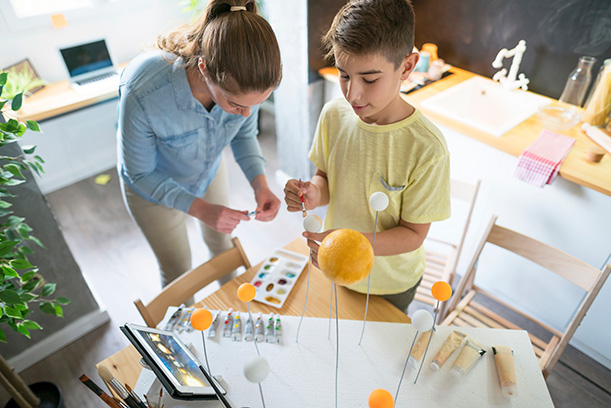BOOMbox at Home: Space Activities
April 30, 2020

Enjoy some of these space related activities.
Gravity Art
Gravity watercolor painting is a fun activity for all ages to learn the concepts of gravity and viscosity. NASA defines gravity as the force of a planet or other body that draws objects toward its center. When you jump up, gravity pulls you back down. Viscosity relates to how thick a liquid is. Maple syrup has a higher viscosity than water, which flows more freely.
There are many ways to do gravity art. Be creative and let your imagination take over.
First, collect your supplies. You will need some sort of canvas, such as thick paper, special watercolor paper, or actual canvases. If you don’t have these types of paper or canvas, experiment with what you do have, like newspaper or printer paper.
You will also need an art medium of your choice. Some options include watercolor, acrylic or tempera paints. You'll also need a paintbrush, pipette, or even a kitchen baster. No paint? No problem! If you don’t have paints available, diluted food coloring will work. It’s best to use diluted versions of any paint you are using to ensure that it has a low viscosity and can flow down the canvas smoothly.
After you collect your supplies, set up your art station on a flat surface like a table or the floor, and cover it with additional newspaper or magazines to protect your work area. With your painting tool, create a design at the top of the canvas while it’s lying flat on a surface. Once the design is completed, pick up your canvas at an angle and watch how gravity makes the paint drip down. Don’t forget to decorate your masterpiece any way you’d like. Now you have a cool piece of art created using the laws of gravity.
Once your artwork is dry, consider hanging it in a window to share with your neighbors as part of the Skokie Spirit Shines Through campaign.
For more information on gravity, visit NASA Space Place. As you create more masterpieces using this method, think about the following questions and discuss your answers with someone or write them down:
- What is gravity?
- How does gravity influence things on Earth?
- How is gravity different on other planets?
For other takes on this activity or more detailed instructions, see the following resources:
Gravity Painting Experiment (Video)
Make Your Own Constellation
Kids and adults alike can create their own constellations and star myths. To do this activity, you need paper and a drawing tool.
Start by having a discussion about what you already know about constellations:
- What shapes do they make?
- What stories are told about them?
You may want to learn more about constellations and their myths. Here are some interesting online resources:
Check out this interactive website with Greek Constellation Myths.
Read about Ancient Chinese Astronomy.
Listen to Native American Star Myths.
Look at side-by-side cards with Greek and Arabic Constellations.
Explore an interactive night sky with Stellarium.
Next, get out your paper and drawing tool. Make some dots on your page--you can intentionally make a shape, but it’s also fun to place the dots at random. You could try closing your eyes while you do this to be surprised by the dots you make. You could make a few dots, or many!
Some constellations (such as Orion) have many stars, while others have only three (like Pyxis). Now it’s time to connect your dots. What shapes do you see forming on the page? Maybe try looking at the page from different angles to get a different point of view.
Next, name your constellation! Does it look like an object that already exists, like a toothbrush or a bicycle? Or is it an original character or object that you invented yourself? What is its story? Often, mythological stories tell the story of how the constellation became a part of the sky. How did your constellation get into the sky?
Bonus constellation activities
Using a different colored pencil or marker, draw a more detailed picture of your constellation. Think about how the picture comes out of the simplified star shapes.
Make a constellation out of existing stars! On a clear night, look at the stars outside (with an adult) and make a constellation based on your observations. Or indoors, use a virtual night sky like Stellariam to choose your stars.
Look Up
With the sun setting later, it’s a great time to get outside and look up to see stars and even planets. You can use the monthly chart from Skymaps.com to identify different celestial bodies with your eyes, binoculars, or even a telescope. Here is May's star calendar for the northern hemisphere.
Adler Planetarium’s #LOOKUP Story series on Instagram shares accessible activities for interacting with the night’s sky. View their #LOOKUP stories on Instagram.
Share
We’d love to see the results of your experiments. Tag @skokielibrary when you share photos of what you’ve created on social media.
This week's post was written with Mahnoor and Frannie.